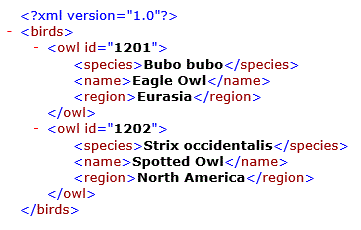 Schema File
Schema File
The schema file is an XML Schema Definition (XSD) or document type definition (DTD) file that provides information about the XML file, such as which elements or attributes are optional and therefore might not appear in this particular XML file but might appear in other XML files of the same schema. The schema file also indicates whether a particular element appears only one time or might appear multiple times.
If you do not provide schema information, either within the XML sample file itself or in a separate XSD or DTD file, the wizard infers the schema from the sample XML file. This inference includes the assumption that elements might be repeated even if the sample XML file contains only one instance of the element. Additionally, when no schema information is present, the data type for all elements defaults to "text." (You can change the data type in the Database Setup dialog.)
The XML schema is not required, but without it, you cannot use any optional fields that are not present in your sample XML.

